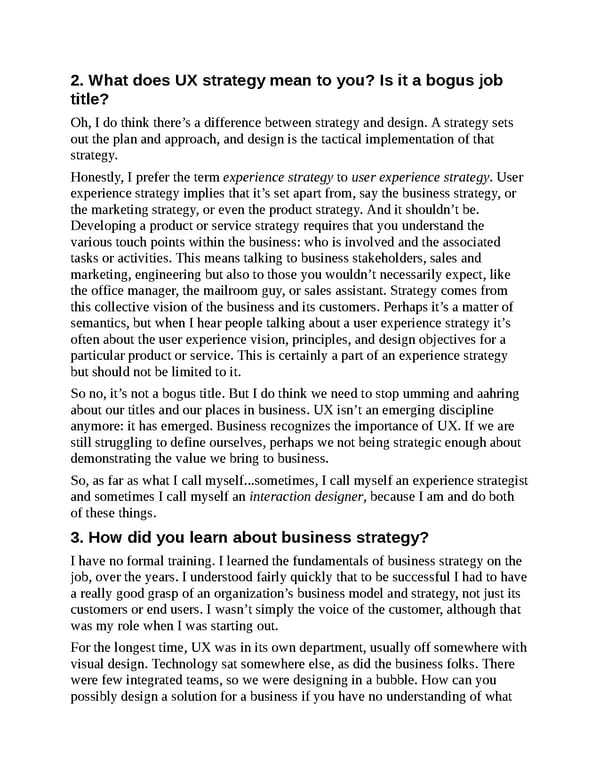2. What does UX strategy mean to you? Is it a bogus job title? Oh, I do think there’s a difference between strategy and design. A strategy sets out the plan and approach, and design is the tactical implementation of that strategy. Honestly, I prefer the term experience strategy to user experience strategy. User experience strategy implies that it’s set apart from, say the business strategy, or the marketing strategy, or even the product strategy. And it shouldn’t be. Developing a product or service strategy requires that you understand the various touch points within the business: who is involved and the associated tasks or activities. This means talking to business stakeholders, sales and marketing, engineering but also to those you wouldn’t necessarily expect, like the office manager, the mailroom guy, or sales assistant. Strategy comes from this collective vision of the business and its customers. Perhaps it’s a matter of semantics, but when I hear people talking about a user experience strategy it’s often about the user experience vision, principles, and design objectives for a particular product or service. This is certainly a part of an experience strategy but should not be limited to it. So no, it’s not a bogus title. But I do think we need to stop umming and aahring about our titles and our places in business. UX isn’t an emerging discipline anymore: it has emerged. Business recognizes the importance of UX. If we are still struggling to define ourselves, perhaps we not being strategic enough about demonstrating the value we bring to business. So, as far as what I call myself...sometimes, I call myself an experience strategist and sometimes I call myself an interaction designer, because I am and do both of these things. 3. How did you learn about business strategy? I have no formal training. I learned the fundamentals of business strategy on the job, over the years. I understood fairly quickly that to be successful I had to have a really good grasp of an organization’s business model and strategy, not just its customers or end users. I wasn’t simply the voice of the customer, although that was my role when I was starting out. For the longest time, UX was in its own department, usually off somewhere with visual design. Technology sat somewhere else, as did the business folks. There were few integrated teams, so we were designing in a bubble. How can you possibly design a solution for a business if you have no understanding of what
 UX Strategy: How to Devise Innovative Digital Products that People Want Page 279 Page 281
UX Strategy: How to Devise Innovative Digital Products that People Want Page 279 Page 281